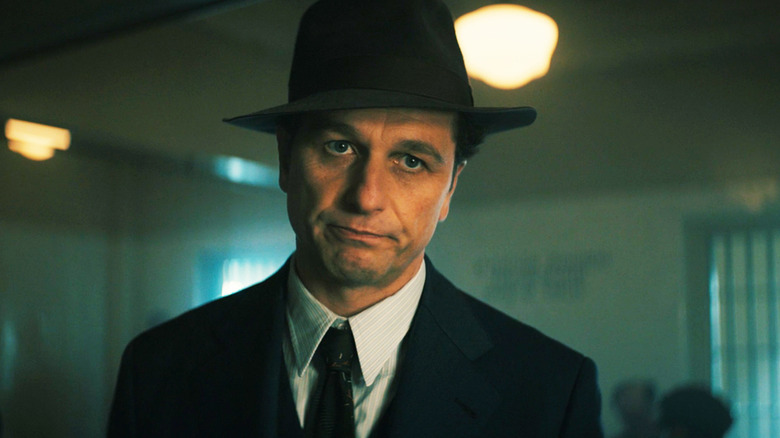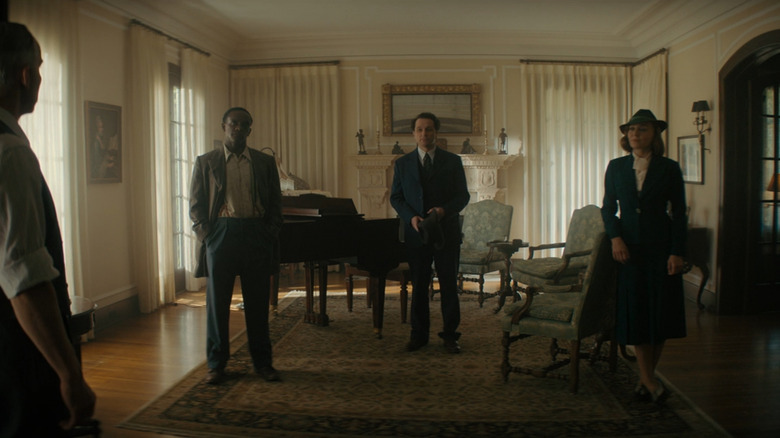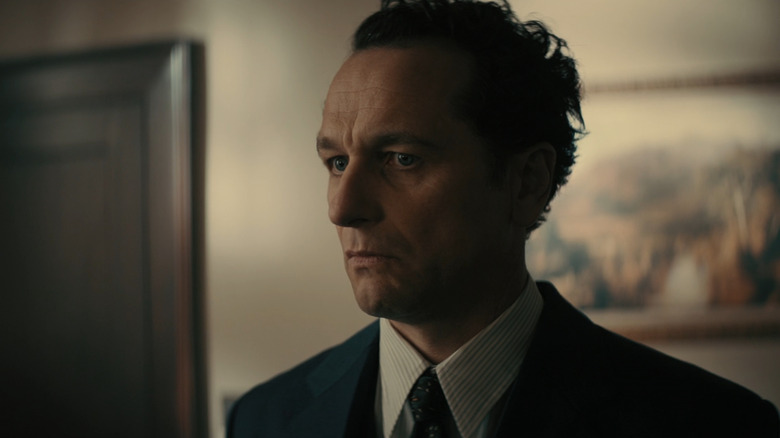Perry Mason Showrunner Divulges Details On A Sacrificed Season 2 Finale Scene
This post contains spoilers for "Perry Mason" season 2.
"Perry Mason" season 2 wrapped up with a bittersweet finale that saw the titular lawyer locked up for his indiscretions, having gotten just one of his clients off the hook. The ultimate episode of what was a stellar season also saw the conniving Camilla Nygaard (Hope Davis)'s scheming revealed, Lydell McCutcheon (Paul Raci) trapped in Japan, and most importantly, the Gallardo brothers spared the noose — even though Mateo (Peter Mendoza) was sentenced to 30 years in jail.
But what about arguably the two standout characters this season, Juliet Rylance's Della Street and Chris Chalk's Paul Drake? Well, things work out relatively well for them, considering the episodes seemed to be building towards some kind of breaking point for both — especially Drake, whose emotional season 2 arc promised to deliver a full-on meltdown that never materialized. Instead, Street manages to stay a closeted lesbian without having her personal life revealed, and Drake gains some clarity on what he wants to do going forward — and it ain't working with Perry Mason.
And while the finale wasn't quite the blowout shocker of a conclusion I was expecting, all in all new showrunners Jack Amiel and Michael Begler managed to craft a compelling season of TV that, dare I say, topped the darker first season of "Perry Mason." 1930s Los Angeles felt more vibrant and alive this time around, even while its sordid underbelly was laid bare. The deeply researched and expertly crafted production design really sold the setting, making me excited to delve back into the intoxicating world of prohibition-era LA each week. Which is why it's a shame that we missed out on a hastily-cut finale scene that would have paid homage to the novelty architecture of the city at the time.
'We just gotta let the cone go'
Michael Begler, who broke down the season finale for /Film, spoke to Script Magazine about the research he did to bring 1930s LA to life, explaining how he discovered so-called "novelty architecture," which basically described buildings made to look like other objects. The Coffee Pot on Wilshire Blvd, for example, was a cafe built to look like a giant coffee pot. And Begler wanted to pay homage to this ostentatious architectural style with his show. Unfortunately, even after building a set and shooting a scene, the moment had to be cut from the season finale. As the co-showrunner explained:
"There was one [example of novelty architecture] called the Giant Cone, and it was a giant ice cream cone on Wilshire Boulevard, upside down. Keith Cunnigham, our production designer, and I talked about it, we loved it. He built it. We shot it, and it looks so cool and so authentic."
According to Begler, the scene included Matthew Rhys' Perry Mason and his young son, Teddy, and involved, "Perry being very straightforward and honest," and "trying to say in his best possible way, 'This is who I am.'" But Begler and the writers wanted to make sure the finale maintained a fast pace throughout, and apparently, the scene didn't fit in As Begler explained:
"Sitting there and seeing the scene, I'm going, "This isn't necessary, this isn't helping our story in the end. It was actually slowing down what we needed to do, the propulsion that we wanted in that final episode because we want the audience constantly leaning in and this...it felt like no matter where we placed it in the episode, it felt like a stall and it was just like, 'Alright, we just gotta let the Cone go...'"
The show didn't need giant cones to be effective
"Perry Mason" season 2 outdid the first in terms of depicting 1930s LA. Perhaps it was the slightly less grim tone that made the setting feel more inviting, but the eight episodes that just wrapped up seemed to so effectively resurrect the city during that era. As Executive Producer Susan Downey explained in a behind the scene featurette, "Season 2's big. It's a lot bigger than season 1. It's more locations, it's more sets, it's more Los Angeles." And that clearly comes across on-screen, with everything from jazz clubs to the shacks of the "Hooverville" set (constructed from the ground up in a Santa Clarita field and named for the President in power at the time the great depression hit) full of meticulous detail.
That's attested to by the historian consultants who worked on the show. Writing for Alta, William Deverell and Elizabeth Logan revealed how dedicated the team behind the show was to keep things factual:
"Emails showed up at all hours of the day and night. 'Do you know anything about nighttime performers?' or 'Would it have been possible to make a telephone call without going through an operator?' Producers and writers sought to understand neighborhoods, the construction and experiences of race, the ins and outs of the early-20th-century criminal legal system, and specific penal code sections. Prop teams and musical wish lists threw us into research on radios, dead bolts, shoes, and horseback-riding fashion."
Maybe next time around we'll get some novelty architecture. But even without the Giant Cone, it's clear the production team was committed enough to historical accuracy to deliver a '30s LA that felt both magical and yet stringently naturalistic.


